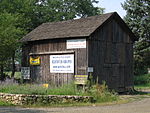Connecticut's 4th congressional district

Connecticut's 4th congressional district is a congressional district in the U.S. state of Connecticut. Located in the southwestern part of the state, the district is largely suburban and extends from Bridgeport, the largest city in the state, to Greenwich – an area largely coextensive with the Connecticut side of the New York metropolitan area. The district also extends inland, toward Danbury and toward the Lower Naugatuck Valley. The district is currently represented by Democrat Jim Himes. With a Cook Partisan Voting Index rating of D+13, it is the most Democratic district in Connecticut, a state with an all-Democratic congressional delegation. Historically, the 4th was a classic "Yankee Republican" district. However, it has not supported a Republican for president since 1988, and has swung increasingly Democratic at the national level since the 1990s. This culminated in 2020, when Joe Biden won it with 64 percent of the vote, his best showing in the state. However, even as the district swung increasingly Democratic at the national level, Republicans usually held this district without serious difficulty until the turn of the millennium. In 2004, however, Democrat Diane Farrell held longtime incumbent Chris Shays to only 52 percent of the vote, the closest race in the district in 30 years. Shays fended off an equally spirited challenge from Farrell in 2006 before losing to Himes in 2008. Himes has held the seat ever since.
Excerpt from the Wikipedia article Connecticut's 4th congressional district (License: CC BY-SA 3.0, Authors, Images).Connecticut's 4th congressional district
Stonebridge Road,
Geographical coordinates (GPS) Address Nearby Places Show on map
Geographical coordinates (GPS)
| Latitude | Longitude |
|---|---|
| N 41.196944444444 ° | E -73.388611111111 ° |
Address
Stonebridge Road
06883
Connecticut, United States
Open on Google Maps








